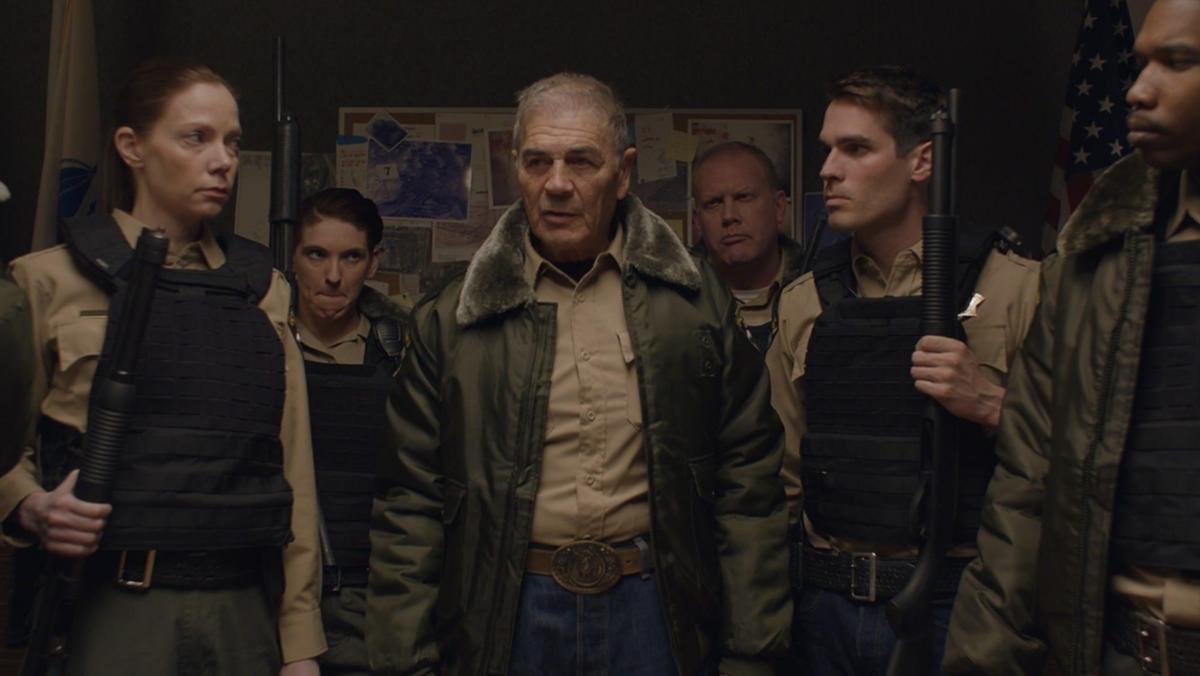At just 80 minutes excluding credits, The Wolf of Snow Hollow has a pretty good amount of things on its mind. Not the wolf itself, though; that’s more of a MacGuffin. In fact, it’s not even too focused on the how of it all. As for the who? Well, it’s not too specific on that either, but what it does ostensibly focus on are the what and why. Alas, without the first two, the others never really come to be.
So, where does that leave us? Snow Hollow, Utah. That’s pretty clear. It’s a mountain town where everyone knows everyone, so it only makes sense that, upon staying in a cabin, two tourists fall victim to a grizzly attack. The evidence doesn’t point to a person but a werewolf instead, full moon and all. But remember, that’s not the real focus here. What is it then? The Wolf of Snow Hollow aims more to be about its small village, but in reality, it’s more about how frayed police officers, especially men, abuse their privileges. It’d be a great vehicle to skewer these topics if the pieces fit together, but they don’t.
Instead, they contradict, an exploration of heady themes strapped down by building-block construction. Its tone is unwieldy, and that isn’t just because of its protagonist. That man is John Marshall (Jim Cummings), a lawman on the verge of an alcoholic relapse. He’s both dismissive and controlling of his college-bound daughter, Jenna (Chloe East). He dumps all his work’s emotional labor onto Officer Julia Robson (Riki Lindhome) and, like almost every man in this town, is a child playing dress-up. The problem with the movie is that it can feel the same way.
The issue here isn’t necessarily a lack of maturity. Neither is it a lack of self-awareness––at least not entirely. It’s that Cummings, who also wrote and directed, seems to have smashed two very different movies together without bothering to thread the needle between its parts. For the first 45 minutes, The Wolf of Snow Hollow is a broad comedy. Characters shake, shout, and stomp at even the idea of losing dominance. The script plants the seeds for Marshall’s irascibility, but the direction and performances take a more detached view of his problems. His misdeeds, much like the supernatural carnage closing in, are for audiences to snicker at from afar rather than examine.
Then what’s with Cummings’ choices as a filmmaker? He and his DP, Natalie Kingston, toy with showy zooms in and out during monologues. The approach to the violence is closer to parody than anything else, at least on a genre level. But when things shift, The Wolf of Snow Hollow becomes another piece of meat altogether. Despite the fragile masculinity the film depicts in the first half, the latter half all but ditches its comedy. Sure, the comedy was quite toothless to begin with, but at least it was consistently glib.
By now, it’s not parodical anymore. It forgoes its genre focus too much for that. It also isn’t that satirical, what with its sudden and near-complete lack of humor. Add in the fact that Cummings’ script is more full of character traits than actual characters, and any attempts at social commentary feel muted. The movie doesn’t truly understand Marshall’s abuse of power because it doesn’t fully understand how others suffer at his hands. The shift in tone doesn’t work because the first half isn’t funny enough for it to actually lose any frivolity. Cummings is okay in his role, but he’s too unintimidating to make an impact.
That proves to be an issue later on, especially when the movie shifts Lindhome farther into the peripheries. Robert Forster also shows up in his final role without much to do, but it’s the fleeting moments when he and Cummings play off each other that The Wolf of Snow Hollow shows a peek of the behavior it tries to comment on. Yes, those moments are there. They just aren’t there enough, and with its inability to weave parody and satire, the final product can’t help but feel incomplete.
The Wolf of Snow Hollow opens in theaters and on demand this Friday, October 9.

